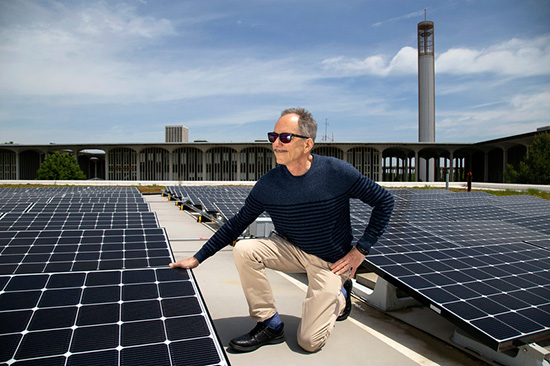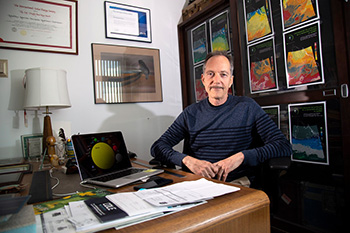Achieving 100 Percent Renewables
Solar Energy Expert Richard Perez Shares His Blueprint for a Carbon-Free Future
 |
|
ASRC Senior Research Associate Richard Perez observes an array of 90 LG 350-watt solar panels installed on the Campus Center West addition roof. (Photo by Patrick Dodson) |
ALBANY, N.Y. (May 30, 2019) – Last year, California set the nation’s most ambitious energy goal — deriving 100 percent of its electrical power from renewable sources by 2045. Many other states have since joined with similar goals, including New York, with Gov. Cuomo’s “Green New Deal” calling for 100 percent carbon-free electricity by 2040.
Though critics argue these targets are not realistic, solar energy expert Richard Perez believes he holds the blueprint to success.
Perez, a senior research associate at the Atmospheric Sciences Research Center (ASRC), has published a new paper in PV-Tech Power that describes his cost-effective solution to bridge the gap between production of renewables — such as solar and wind — and customer demand. It combines the use of oversized renewable assets and energy curtailment.
According to Perez, energy storage technologies have long been considered a critical component of achieving high use of renewables. For example, solar photovoltaic (PV) panels can collect energy from the sun during the daytime and use electrochemical battery storage to meet demands after sunset and during winter or other seasonal variations. However, large and longer-timescale solar supply gaps are more complicated and expensive to maintain.
 |
|
Perez spends much of his time disseminating and explaining solar energy’s vast potential to power the planet. (Photo by Patrick Dodson). |
Instead, Perez and his co-authors suggest a "counterintuitive strategy." By building oversized renewable assets, more energy is produced, limiting seasonal imbalances and the need for a large amount of storage. The oversizing strategy is combined with a practice called curtailment, which reduces output to below capacity during peak times, saving money and resources.
“There are many promises for 100 percent renewables in the next 25 to 30 years. We’re creating a realistic, a cost-effective solution to get us there,” Perez said.
Clean Power Research recently tested this method on the Minnesota power grid. By combining oversized renewable assets with curtailment, the total electricity storage size was reduced by a factor of 10. The study projected that wind and solar could meet 95 percent of the state’s energy needs by 2050 at a cost of 3.5 cents/kWh — lower than current wholesale market prices.
Perez said the study's results validated that “synergies between overbuilding and curtailment can transform solar and wind into dispatchable resources capable of meeting customer demands at all times and at a reasonable cost.”
“Today, no one is talking about overbuilding and curtailment as a realistic solution,” Perez said. “It’s time to shift from thinking about how to monetize every unit of renewable energy and instead focus on how to balance the supply and demand throughout the year.”
Along with Perez, the paper’s other co-authors include: Karl Rabago, executive director of the Pace Energy and Climate Center at Pace University; Marc Perez, a senior researcher at Clean Power Research in California; and Morgan Putnam, vice president of solar analytics at REsurety.
Interested in learning more? Watch Perez’s 3-minute YouTube explainer on his scalable strategy to 100 percent renewables, which he refers to as the “Perfect Forecast.” You can also view his University expert page, article in The Conversation and UAlbany News Podcast segment.
In April, SUNY Chancellor Kristina M. Johnson announced a new clean energy road map for the system’s 64 campuses in partnership with state agencies in order to accelerate progress toward Cuomo’s decarbonization goals. The New York Power Authority is the effort’s lead agency, with input and cooperation from the New York State Energy Research and Development Authority, the Department of Public Service and the Long Island Power Authority.
![]() For more news, subscribe to UAlbany's RSS headline feeds
For more news, subscribe to UAlbany's RSS headline feeds
A comprehensive public research university, the University at Albany-SUNY offers more than 120 undergraduate majors and minors and 125 master's, doctoral and graduate certificate programs. UAlbany is a leader among all New York State colleges and universities in such diverse fields as atmospheric and environmental sciences, business, education, public health,health sciences, criminal justice, emergency preparedness, engineering and applied sciences, informatics, public administration, social welfare and sociology, taught by an extensive roster of faculty experts. It also offers expanded academic and research opportunities for students through an affiliation with Albany Law School. With a curriculum enhanced by 600 study-abroad opportunities, UAlbany launches great careers.


